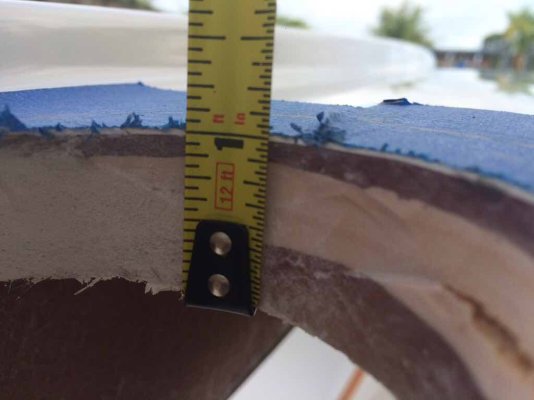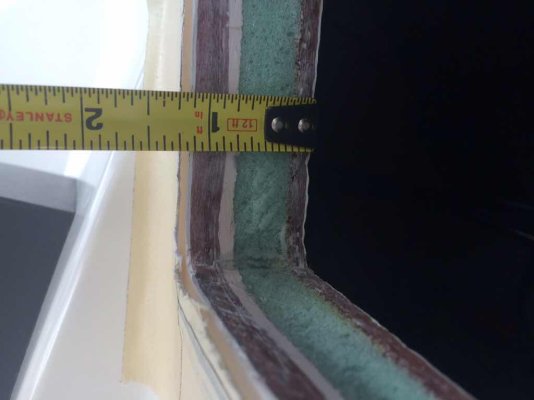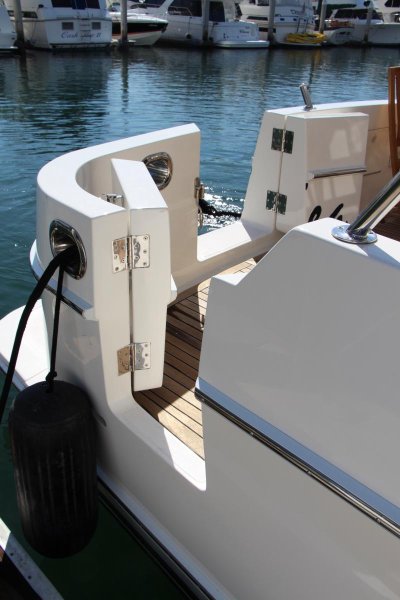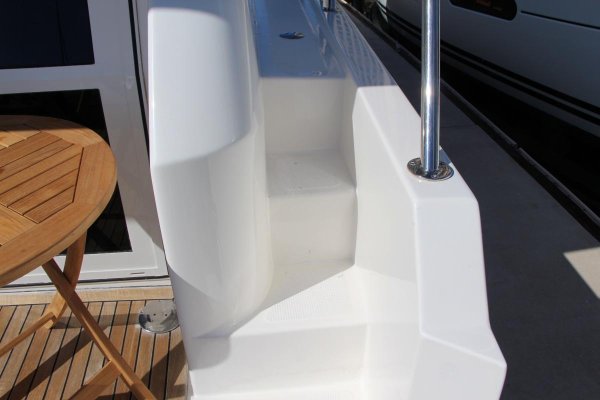You are using an out of date browser. It may not display this or other websites correctly.
You should upgrade or use an alternative browser.
You should upgrade or use an alternative browser.
Thick!
- Thread starter N4712
- Start date
The friendliest place on the web for anyone who enjoys boating.
If you have answers, please help by responding to the unanswered posts.
If you have answers, please help by responding to the unanswered posts.
N4712
Guru
- Joined
- Apr 22, 2013
- Messages
- 3,607
- Location
- U.S.A
- Vessel Name
- Oliver
- Vessel Make
- Nordhavn 47 Hull# 12
Rod holders on a Nordhavn?
Seriously I can't see the core/laminate interface on the round hole but the VHF cutout is clear. That glass is twice as thick as what I have seen on other boats in the same area.
David
No this on the Tender to the big boat. The center console we tow.
Putting Rod holders and a VHF in the trusty T/T Oliver and cut the holes and was damned surprised how thick the gunnels and console were. No wonder she's so slow even with the max rated hp that she has. Looks like it should out live me.
]
Absolutely. The reason Whalers really need one engine size beyond their rating but that's just not advisable from a liability point. Definitely not flimsy. You should save that cutout so if you ever decide to sell it, you can dazzle someone by showing the construction. I'm glad Whalers haven't deserted what they are. They could build lighter or faster or anything, but then it just wouldn't be a Whaler.
N4712
Guru
- Joined
- Apr 22, 2013
- Messages
- 3,607
- Location
- U.S.A
- Vessel Name
- Oliver
- Vessel Make
- Nordhavn 47 Hull# 12
Didn't know it was a Dusky. Well, whatever it is, it's thick.
Yep, you know about them right? The only problem I have is that the gel-coat is slightly to thick in places and where's its thick its spider cracks a little.
Yep, you know about them right? The only problem I have is that the gel-coat is slightly to thick in places and where's its thick its spider cracks a little.
Had heard of them and know where they're located, don't know that I've seen any in use but they have a very large offering. Probably have seen some around and just not known.
RT Firefly
Enigma
THICK...as a brick.
twistedtree
Guru
The Nordhavn fly bridge console, by the way, is 2" thick. That's thicker than the hull on my old Grand Banks. It's no wonder the boat weighs 140,000 lbs.
eyschulman
Guru
- Joined
- Apr 1, 2014
- Messages
- 1,288
Heavy and thick are not necessarily indicators of good construction. Light and well engineered is usually far better for any conveyance that needs to move under some source of power. The thickness of a plug as an isolated example of construction is meaningless other than as an insight into the building material and how laid up. A heavy boat may have some advantages in comfort but it is not necessarily stronger than a well built and engineered light boat. To build a big Nordhaven or its tender light and strong would probably double the price.
HopCar
Guru
- Joined
- Aug 20, 2011
- Messages
- 5,308
- Vessel Name
- Possum
- Vessel Make
- Ellis 28
Dusky had a rough start. I remember seeing a Dusky with stringers broken loose from the hull back in the early seventies. They've come a long way and seem to be pretty good boats now.
They sponsor a local fishing guide called Bouncer Smith. I've fished with him. He works his Dusky hard and it doesn't break.
If you want to fish out of Miami, try to get a charter with Bouncer. He is a really nice guy and will put you on fish.
They sponsor a local fishing guide called Bouncer Smith. I've fished with him. He works his Dusky hard and it doesn't break.
If you want to fish out of Miami, try to get a charter with Bouncer. He is a really nice guy and will put you on fish.
Heavy and thick are not necessarily indicators of good construction. Light and well engineered is usually far better for any conveyance that needs to move under some source of power. The thickness of a plug as an isolated example of construction is meaningless other than as an insight into the building material and how laid up. A heavy boat may have some advantages in comfort but it is not necessarily stronger than a well built and engineered light boat. To build a big Nordhaven or its tender light and strong would probably double the price.
To build a Nordhavn light and strong you'd lose some of the abilities as far as crossing oceans and being comfortable rough water boats. Each type boat has and needs different characteristics. I would not say heavy and thick is good in a boat like the Dusky. Fountains you want light and strong and you'll spend more to do that. Sportfishing boats light and strong and also many do a great job in rough waters at good speed. But they don't have the range of a Nordhavn, nor do they do especially well at displacement speeds.
I don't think Oliver was presenting the Dusky as being some great boat, simply commenting on the thickness and on the fact it's a bit heavy and sluggish. Certainly the plug doesn't define the overall quality.
eyschulman
Guru
- Joined
- Apr 1, 2014
- Messages
- 1,288
Band B not my idea but the light long and skinny versions of ocean hoppers being developed and tested are targeted at outdoing the NH and its close cousins. The goal is to achieve greater speed for less fuel and with proper weight distribution and stabilization greater comfort in half the passage time. The lessons learned in other industries will and are creeping into boat engineering and construction. Sail boats because of their use in open water and transoceanic racing have led the industry and power boats are following. There will always be a place for the old school boats but it will not be first across the finish line nor necessarily the strongest built or most comfortable. My point regarding plug thickness comes down to thick construction is often old school mentality.
FF
Guru
- Joined
- Oct 12, 2007
- Messages
- 22,552
In the photo the glass would seem to be 1/4 thick on either side of the core.
So its 1/2in total of glass.
Thats about right , the core adds stiffness not much strength .
GRP is easily strong enough , the hard part is to be stiff enough , and a 3/4 inch core adds plenty of stiffness.
This use of 1/4 glass ,3/4 foam and 1/4 glass would be the normal requirement for an offshore boat .
The layup is costly and expensive (depending on the foam) and is one method of having blue water scantlings , and one reason an offshore boat costs 300% more .
So its 1/2in total of glass.
Thats about right , the core adds stiffness not much strength .
GRP is easily strong enough , the hard part is to be stiff enough , and a 3/4 inch core adds plenty of stiffness.
This use of 1/4 glass ,3/4 foam and 1/4 glass would be the normal requirement for an offshore boat .
The layup is costly and expensive (depending on the foam) and is one method of having blue water scantlings , and one reason an offshore boat costs 300% more .
Keysdisease
Guru
The thickness of a plug as an isolated example of construction is meaningless other than as an insight into the building material and how laid up.
Far from meaningless when selling a boat. An excellent tool for use on the starry eyed future owner.

N4712
Guru
- Joined
- Apr 22, 2013
- Messages
- 3,607
- Location
- U.S.A
- Vessel Name
- Oliver
- Vessel Make
- Nordhavn 47 Hull# 12
Band B not my idea but the light long and skinny versions of ocean hoppers being developed and tested are targeted at outdoing the NH and its close cousins. The goal is to achieve greater speed for less fuel and with proper weight distribution and stabilization greater comfort in half the passage time. The lessons learned in other industries will and are creeping into boat engineering and construction. Sail boats because of their use in open water and transoceanic racing have led the industry and power boats are following. There will always be a place for the old school boats but it will not be first across the finish line nor necessarily the strongest built or most comfortable. My point regarding plug thickness comes down to thick construction is often old school mentality.
I'd rather comfortably cross the ocean in my floating condo (Nordahvn) then a light and skinny barebones coffin that can go fast. No thank you, I'm not trying to break records.
The plug to me is worth a thousand words. If it's worthless to you, then great.
The condo

The coffin


Codger2
Guru
- Joined
- Oct 11, 2007
- Messages
- 6,691
- Location
- US
- Vessel Name
- Circuit Breaker
- Vessel Make
- 2021..22' Duffy Cuddy cabin
Heavy and thick are not necessarily indicators of good construction. Light and well engineered is usually far better for any conveyance that needs to move under some source of power. /QUOTE]
Well....I don't know about you but "heavy & thick" sure floats my boat when the sea starts to kick up! I feel more at ease than when I'm bobbing like a cork in "light & well engineered" boats.
Last edited:
Codger2
Guru
- Joined
- Oct 11, 2007
- Messages
- 6,691
- Location
- US
- Vessel Name
- Circuit Breaker
- Vessel Make
- 2021..22' Duffy Cuddy cabin
That's been my experience on my boat. The gel coat is too thick!The only problem I have is that the gel-coat is slightly too thick in places and where's its thick its spider cracks a little.
(Edit) The photos don't show the "spiders" in the radii of the glass.
Attachments
twistedtree
Guru
Band B not my idea but the light long and skinny versions of ocean hoppers being developed and tested are targeted at outdoing the NH and its close cousins. The goal is to achieve greater speed for less fuel and with proper weight distribution and stabilization greater comfort in half the passage time. The lessons learned in other industries will and are creeping into boat engineering and construction. Sail boats because of their use in open water and transoceanic racing have led the industry and power boats are following. There will always be a place for the old school boats but it will not be first across the finish line nor necessarily the strongest built or most comfortable. My point regarding plug thickness comes down to thick construction is often old school mentality.
I don't think anyone is "learning" from sail boats. It's all well known. Ocean-going trawlers CHOOSE to be different from sail boats, favoring space and comfort over speed at any cost. See Oliver's post about Condo vs Coffin. The Dashew style sail boat hull with a motor and without a keel have their place and clearly some number of people like that balance. Just keep in mind that even boats traveling all over the world spend 10% or less (probably a lot less) of their time doing multi-day passages, so you need to think carefully about how much you optimize for that 10% at the expense of the majority 90%.
Codger2
Guru
- Joined
- Oct 11, 2007
- Messages
- 6,691
- Location
- US
- Vessel Name
- Circuit Breaker
- Vessel Make
- 2021..22' Duffy Cuddy cabin
I don't think that's the case at all!...... the light long and skinny versions of ocean hoppers being developed and tested are targeted at outdoing the NH and its close cousins.

eyschulman
Guru
- Joined
- Apr 1, 2014
- Messages
- 1,288
Pretty much all the above arguments about lighter boats were raised when lighter(not nec. ultra light) modern sailing craft including multihulls came along. With sailing craft it has become apparent that light modern craft are safe and can be comfortable. I am not talking radical light but when comparing my previous J/44 at 24,000 lb to an equivalent older 44 boat at 50,000lb the ocean crossing abilities were very significant. If you spend two weeks less out in open water you are that much safer. If one's mind set is firmly in the camp of heavy is better than the NH should have a heavy steel hull and there are plenty of offshore boat builders who may agree since that's how they build. This type of difference of opinion can never be resolved. The hard numbers regarding passage times and fuel burn can be compared but things like comfort, and perception of build quality, and safety are often more subjective. As for plugs yes they can say a lot about a build but the thickness is not the key point. A thick plug with bad materials or poor laminate technique may be far inferior to a thin plug.
Pretty much all the above arguments about lighter boats were raised when lighter(not nec. ultra light) modern sailing craft including multihulls came along. With sailing craft it has become apparent that light modern craft are safe and can be comfortable. I am not talking radical light but when comparing my previous J/44 at 24,000 lb to an equivalent older 44 boat at 50,000lb the ocean crossing abilities were very significant. If you spend two weeks less out in open water you are that much safer. If one's mind set is firmly in the camp of heavy is better than the NH should have a heavy steel hull and there are plenty of offshore boat builders who may agree since that's how they build. This type of difference of opinion can never be resolved. The hard numbers regarding passage times and fuel burn can be compared but things like comfort, and perception of build quality, and safety are often more subjective. As for plugs yes they can say a lot about a build but the thickness is not the key point. A thick plug with bad materials or poor laminate technique may be far inferior to a thin plug.
We're not a sailing group though and when it comes to power boats, the consumer has spoken over and over and while narrow and light is popular for high performance boats when it comes to trawler buyers and yacht buyers it's been soundly rejected. There is nothing new about the concept. Yes, if you want the most economical loop boat, just get a sail boat and remove the sails. But 99.9% of power boat owners do not want to spend a year or two looping on that boat.
People don't want the absolutely most fuel efficient streamlined boat, they want something in between. If they wanted that, they'd just put motors on kayaks and go.
You are right that if one wants more weight and a better crossing than NH they can go to steel. But steel comes with it's negatives and NH makes a good compromise. All boats are compromises. I'm personally not an NH fan, but I don't argue with the facts that they're very popular and their customers on the whole are extremely happy with them. And the NH customer is not about to switch to long, skinny and light. That isn't who that boat would even be targeting. It's real target is the sailor coming over to the dark side of power who appreciates the design and efficiency and doesn't mind the aspects of it that most traditional power boaters dislike.
Your perfect boat, eyshulman, is not one the majority of the market has interest in and has not yet ever been shown to have commercial viability. I do hope one day you're lucky enough to get one. But if I won one in a lottery tomorrow, it would be on the market to be sold the next day. Just we're all after different things.
Long, skinny and light is different to different people too. William Garden believed in the concepts but just applied them in different ways. For instance, most Westports are Garden designs and they'll all run 25 knots WOT and cruise at 20, from the just dropped 85' to the 164'. Of course, the 85' carries 3000 hp and consumes 80 gph at 20 knots and the 130' carries 5780 hp and consumes 130 gph at 20 knots. However, that is significantly better both performance and fuel wise than most other boats in that size range. By comparison a 100' Hatteras requires 5200 hp to run the same speeds as the 130' WP and consumes 150-160 gph doing it.
Most engineering concepts are not applied in their purest forms but used to improve boats that are in the market place and meet needs. In my previous work life our engineers developed the absolutely scientifically proven best bath towel ever. It dried better, was better for one's skin, and it would quickly dry out and no mildew or smell. Washed well and lasted three times as long as traditional towels. Only one problem Took it to a focus group and not a single person said they would ever buy one. The consensus, "It looked and felt odd." Who knows, it may resurface in 20 years. But the consumer speaks last and most powerfully.
Nomad Willy
Guru
Excess weight is bad wherever it is in vehicles.
My Willard gave me the opposite experience. A much smaller boat but a plug taken out of the hull just inbd of the chine was only 3/8ths to 7/16" thick. I was expecting about 1/2". We have slammed into a large log and T boned an adult male Humpback whale w/o the slightest damage. So if she can take 12 to 15' seas (and I'm quite sure she can) she's strong enough.
In the 50s cars had such thick fenders one could do just about anything w them and I never altered the shape of them w my body. New cars are so thin I could easily pound many dents in them w/o damage to my body. Nobody is complaining about them being too weak though. Early FG boats of the 50s Nd 60s were way heavier than present day boats. I suspect passagemaker are a repeat of the cars in that if one dosn't really know how strong and thick they need to be ... better error on the heavy side for structure.
Another good reason not to buy a passagemaker unless you plan to cross oceans. And then since passagemakers are new and the learning curve high perhaps buying the latest developed boat could be a wise move. Buying a passagemakers to coastal cruise is not smart IMO.
But Dusky (name of boat I assume) still does very very well at coastal cruising as well as passage making but an equal quality coastal cruiser would be lighter and better in most all ways I'm think'in. In this game one tends to think "the heavier the better" but I think as long as it's heavy enough any more weight is a bad thing ... absolutly undesirable.
My Willard gave me the opposite experience. A much smaller boat but a plug taken out of the hull just inbd of the chine was only 3/8ths to 7/16" thick. I was expecting about 1/2". We have slammed into a large log and T boned an adult male Humpback whale w/o the slightest damage. So if she can take 12 to 15' seas (and I'm quite sure she can) she's strong enough.
In the 50s cars had such thick fenders one could do just about anything w them and I never altered the shape of them w my body. New cars are so thin I could easily pound many dents in them w/o damage to my body. Nobody is complaining about them being too weak though. Early FG boats of the 50s Nd 60s were way heavier than present day boats. I suspect passagemaker are a repeat of the cars in that if one dosn't really know how strong and thick they need to be ... better error on the heavy side for structure.
Another good reason not to buy a passagemaker unless you plan to cross oceans. And then since passagemakers are new and the learning curve high perhaps buying the latest developed boat could be a wise move. Buying a passagemakers to coastal cruise is not smart IMO.
But Dusky (name of boat I assume) still does very very well at coastal cruising as well as passage making but an equal quality coastal cruiser would be lighter and better in most all ways I'm think'in. In this game one tends to think "the heavier the better" but I think as long as it's heavy enough any more weight is a bad thing ... absolutly undesirable.
Last edited:
Excess weight is bad wherever it is in vehicles.
.
Good in dump trucks.
N4712
Guru
- Joined
- Apr 22, 2013
- Messages
- 3,607
- Location
- U.S.A
- Vessel Name
- Oliver
- Vessel Make
- Nordhavn 47 Hull# 12
Ok let me clear some things up, this is the "Dusky" or one of the tenders to the Nordhavn. She's a great little fishing, skiing, or just romp around boat.

Like Peter said if I wanted to cross oceans everyday the skinny lighter boat maybe the way to go. But up aheads plans involve crossing a handful of large bodies of water. So I'm not too worried. I like my floating condo that has the ability to cross oceans.

Like Peter said if I wanted to cross oceans everyday the skinny lighter boat maybe the way to go. But up aheads plans involve crossing a handful of large bodies of water. So I'm not too worried. I like my floating condo that has the ability to cross oceans.
Similar threads
- Replies
- 11
- Views
- 1K
- Replies
- 10
- Views
- 4K
- Replies
- 4
- Views
- 491








